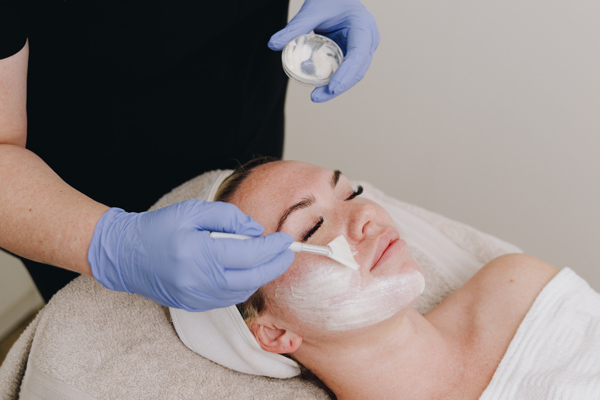Chemical Peels Questions Answered

Your chemical peel questions answered
Let’s be honest. When you see the world peel you probably think of that episode of Sex and the City right? We’re here to tell you that peels have come a long way since then… like a long way.
Chemical peels, despite their name, can deliver an abundance of incredible skin corrective outcomes for many skin types, yes, even sensitive ones.
If you have avoided a peel in the past, out of fear of looking a little too like Samantha Jones, keep reading as we answer your most commonly asked peel questions.
How does a peel actually work?
Chemical peels are designed to renew the texture of your skin by causing the skin to shed cells. This process not only reveals brighter and fresher looking skin but also addresses textural irregularities, addresses the signs of ageing and stimulates collagen production. The strength of the peel itself will determine how many of those layers are treated and therefore, how many cells are shed and any associated downtime.
What can a peel treat?
One of the best things about peels is that they can be customised to treat a wide range of skin concerns. They’re a results-driven approach to improving your skin texture, addressing the signs of ageing, reducing the appearance of sun damage and pigmentation as well as supporting breakouts, blemishes and congestion. Like many forward-thinking skin treatments, more than one peel is generally required to achieve optimal results, especially if we’re reducing the likes of pigmentation, sun damage and fine lines.
What ingredients are behind an efficacious peel?
As all peels are formulated differently and its always best to seek the support of a professional when going down this treatment route. As much as we love an at-home facial, a professional-strength peel isn’t on this list!
Now, we don’t like to play favourites, but these are some of our favourite ingredients to harness during peel treatments.
Entry level peels, ideal for newbies and more sensitive skin types, will love an enzyme-based peel. Enzymes are naturally derived from fruits and plants like papaya and pineapple and eat away at the skin cells gently yet effectively. These have no downtime and are often performed in conjunction with other facial treatments.
Now, let’s talk acids. Again, another word in the world of beauty that has a bad rap! Just like chemical peels, acids are not always as scary as they sound!
AHA, or Alpha Hydroxy Acids, pop up in peels in the form of lactic, malic, mandelic and glycolic acids. We won’t get too sciencey on you but an AHA has a larger molecular structure which means they’re going to work on the surface of the skin and offer a more superficial treatment.
BHA, or Beta Hydroxy Acids, on the other hand, have a much lighter molecular structure which means it can penetrate to the pores. The most well-known BHA in the world of peels is Salicylic Acid, a hero for those that experience breakouts. This is because when it travels to the pores, it can dissolve the “glue” keeping your congestion together and give those pores a serious clean out.
When we’re tackling pigmentation, sun damage and scarring, Kojic Acid is a total powerhouse. This acid is known for its lightening and brightening abilities thanks to its ability to block tyrosinase, therefore, inhibiting the production of excess pigment. This means the likes of sunspots, pigmentation and dark spots are significantly faded.
Do all peels have downtime?
This is the biggest misconception about peels. No, not all peels have intensive post-treatment downtime, especially if they’re entry-level or superficial peels. In fact, many of these lower-strength peels can be combined with other facial treatments like LED!
If you’re chasing fast results, ready to really address your niggling skin concern or have a special event coming up, then a peel with some associated downtime may be your option. It’s important to share all these juicy details with us during your consultation so we can recommend the appropriate course of action.
Is one peel enough?
As much as we’d loved to say one chemical peel is enough, you’re going to get optimal results with a course of treatments. This is the case for many advanced treatments, so commitment (and patience) is key.
Generally, six to eight peel treatments are required for long-term results. From there, we can get stuck into maintenance treatments and a solid at-home skincare routine.
How do I get started?
It couldn’t be easier! We recommend booking yourself a skin consultation so we can get to know your skin on a much deeper level. This is your opportunity to share not just your skin concerns but your goals, lifestyle, the products you’re loving (and not loving) at the moment and any treatments you’ve tried in the past. From there, we can recommend an appropriate peel treatment which may include other treatments or products for optimal results.
Simply visit our website or call us in-clinic to learn more!
RECENT POSTS & TIPS
- IPL Skin Rejuvenation: Unveiling the magic for the most common Skin Concerns
- 5 Signs It's Time To Book An IPL Treatment During The Cooler Seasons
- Your Guide to Glowing Skin in 2024: Tailoring Your Journey to Radiant Results
- Accelerate Your Skin Results: 3 Ways Skin Analysis Transforms Your Skin Journey
- It's time we talked about Winter skin
- Ready to level up your skin needling treatments? Here’s how.
- It’s time for a change
- 4 Promises to make to your skin in 2022
- Get to know our new MediLUX LED
- The Ultimate Post-lockdown Treatment Wish List
LOVE THE SKIN YOU'RE IN
Enchanted Skin & Beauty offers one of the most complete and sought after ranges of professional treatments and skincare in a friendly, and relaxing atmosphere.
Blending artistic vision with technical expertise, providing our clients with the finest of skin treatments available.
Personalising treatments and services, just for you, to create a private oasis from the demands of life. Providing services for both men and women of all ages and lifestyles.







